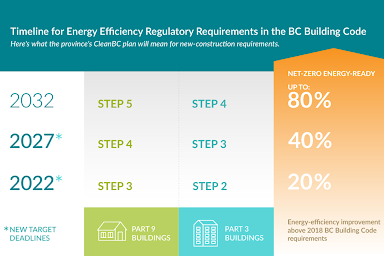What kind of house should be built today?
Contemporary homes in BC, Canada, need to be energy-efficient to reduce greenhouse gas emissions, lower energy costs, and promote sustainable living, with BC’s building codes evolving to reflect this with standards like the Net-Zero Energy Ready (NZER) standard. BC is aiming to make all new homes highly energy efficient by 2032.
In British Columbia, building a contemporary, energy-efficient home with a focus on sustainable materials and design is a good approach, considering the climate and current building trends.
The National Energy Code of Canada for Buildings (NECB) divides Canada six climate zones (4, 5, 6, 7A, 7B, and 8) based on heating degree-days (HDD), which measure the number of degrees Celsius a day’s average temperature is below 18°C, for energy efficiency and building standards, ranging from <3000 HDD (Zone 4) to ≥7,000 HDD (Zone 8).
Climate Zone 4: The warmest zone, requiring less insulation in buildings. Victoria and Vancouver are in Climate Zone 4.
Climate Zone 8: The coldest zone, requiring the most insulation. Smith River is in Climate Zone 8.

- To build an energy-efficient house, focus on a tight building envelope with excellent insulation, high-performance windows and doors, and efficient appliance and lighting systems, while also considering passive solar design and renewable energy options.
BC Energy Step Code: Ensure your home meets or exceeds the requirements of the BC Energy Step Code, which promotes energy-efficient building practices. As of May 1, 2023, the BC Building Code (the Code, aka BCBC) requires 20%-better energy efficiency for most new buildings in B.C. This is equivalent to

- Step 3 for Part 9 buildings (i.e. small buildings, including single-family homes, that are three stories or less in height and have a building area of 600 square meters or less, with occupancies classified as residential, business/personal services, mercantile, or low-to-medium hazard industrial) and
- Step 2 for Part 3 buildings (buildings exceeding 600 square meters in building area or three stories in height; Examples include condos, apartment buildings, care facilities, daycares, etc.)
BC requires all new Part 9 buildings (which we will focus on in this post) to be in Step 5 by 2032, which is 7 years from today. Many new buildings are reaching Step 4 and Step 5 nowadays ahead of the building code requirement. This is because the energy efficiency when reaching a higher step code means more comfort to the occupants, a lower energy bill, and creating a more friendly environment by adding a low single digit increment to the building cost.
Zero Carbon Step Code: Like the BC Energy Step Code, the Zero Carbon Step Code is a flexible, predictable plan to improve new buildings over time, with the objective to reach zero emissions from all new buildings by 2030. It complements the BC Energy Step Code by reducing emissions while improving energy efficiency. Together, they make buildings that are cleaner, more energy efficient, and affordable to operate. Similar to the BC Energy Step Code, the Zero Carbon Step Code is based on different, measurable Steps. In general terms, these Carbon Steps can be referred to as:
- Moderate Carbon Performance (EL-2)
- Strong Carbon Performance (EL-3)
- Zero Carbon Performance (EL-4)
Air Sealing: Prioritize sealing all air leaks in the building envelope (walls, floors, ceiling) to prevent drafts and energy loss.
High-Performance Insulation: Use high-quality insulation to minimize energy loss, especially in the walls of the building, exposed floor, and above the ceiling. It is also a recommendation to add insulation under the slab of the foundation regardless if the foundation is Slab-on-grade, basement, or crawlspace, or a combination of them.
Windows & Doors: Reduce the number of windows to a as needed basis as windows are the highest contributor to the heat loss in the contemporary housing. Choose high-performance windows and doors with features like triple glazing, low-E coatings, and tight seals even in the climate zone 4 areas.
Energy-Efficient Appliances and Systems: Opt for appliances and HVAC systems with high Energy Star ratings.
- Cooktop – induction cooktops are more energy efficient and take shorter time to bring up the heat than the traditional electric and gas cooktops.
- Heating – Heat pumps are more energy efficient than conventional finances that are powered by fossil fuels or electricity.
- Heat Recovery Ventilation / Energy Recovery Ventilation capture and recycle heat from indoor air while bringing in fresh outdoor air. They improve air quality and reduce heating costs by exchanging heat and moisture between incoming fresh air and outgoing stale air.
- Domestic Hot Water – Heat Pump Water Heater is the most energy efficient than traditional tank type water heaters, potentially saving up to 70% on energy costs.
- Dryers – Heat pump dryers are more energy-efficient than vented dryers because they recycle air and condense moisture, while vented dryers expel hot, moist air outside, leading to higher energy consumption
Lighting:
- LED Lighting: Replace traditional incandescent bulbs with energy-efficient LED bulbs.
- Natural Light: Maximize natural light by strategically placing windows and using light-colored interior surfaces.
- Smart Lighting: Consider smart lighting systems that can be controlled remotely or based on occupancy.
Assess Energy Usage: Put in the power meter to measure the electricity usage in real time. Regularly assess your home’s energy usage to identify areas for improvement.
Passive Solar Design: Consider the orientation of the house to maximize natural light and heat gain in the winter and minimize heat gain in the summer.
Smart Home Technology: Integrate smart home systems for energy management and automation. Solar Panels: Install solar panels to generate electricity from the sun.